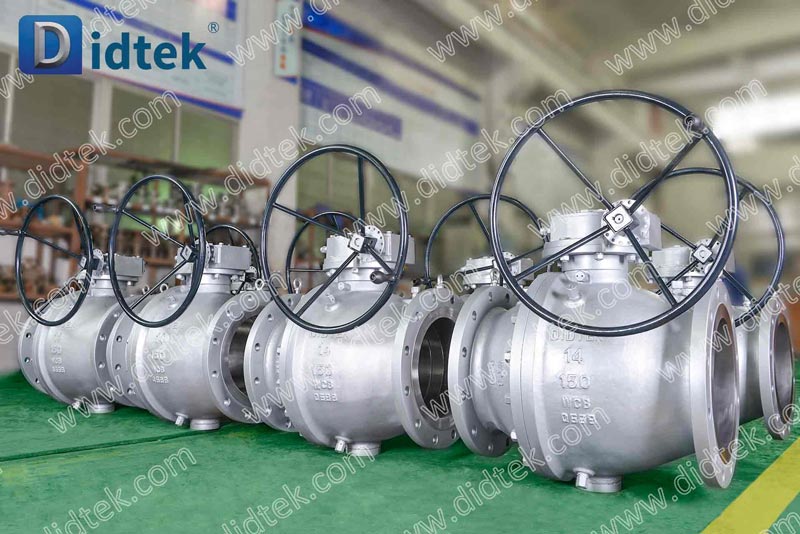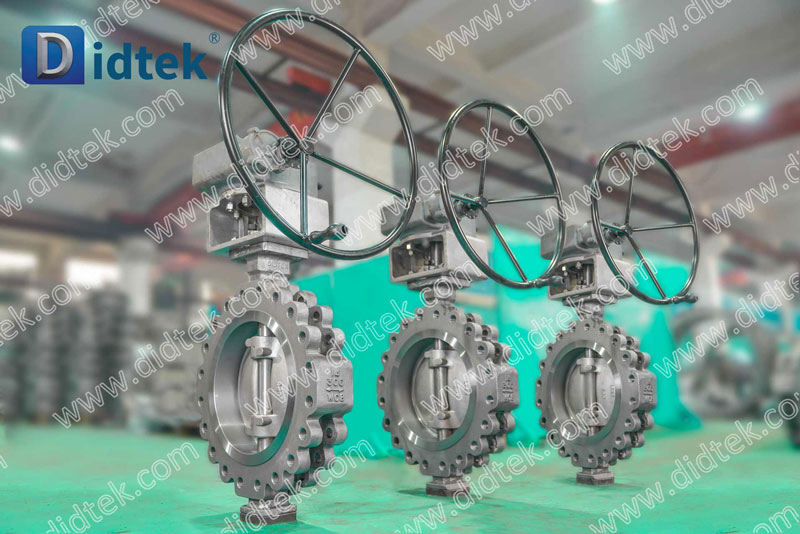When Didtek designing and building a piping system — whether for food and beverage production, municipal water supply or biochemical treatment —using the correct type of valve is critical. Doing this will ensure your plumbing system runs smoothly and can be maintained and repaired as needed.
Here, Didtek describe the similarities and differences between ball valves and butterfly valves, including when to use one over the other.
Ball Valve

Ball valve are quarter turn on/off valve used to control the flow of liquid or gaseous media. As the name suggests, they rely on a hollow swivel ball that rotates 90° to stop or allow media to pass through the port (or bore).
Ball valve are operated by automatic or manual actuation; they can be operated pneumatically, hydraulically or electrically, or most commonly manually via a lever handle. The position of this lever provides a visible cue to indicate whether the valve is open or closed. Ball valves provide an option for faster on/off media control compared to valves that require a full turn or multiple turns to reach their open or closed position.
One-way or two-way ball valves have a single port through the center of the ball, but multi-port ball valves are also available for applications that require the flow of media to be diverted (or selected) in more than one direction, or to handle media from different sources in a piping system. Ball valves are available in full port, standard port, reduced port and V port configurations. There are also a variety of body designs to choose from such as 1-piece, 2-piece and 3-piece valve body.
Most ball valves can operate in a relatively high pressure environment and a wide range of media temperatures. Minimum pressure drop. (Full port ball valve design completely prevents pressure drop.)
When to Use Ball Valve
Ball valve are popular for their durability, versatility, fast cycle times, and tightness, and are often used in a variety of industrial and residential applications. They can handle fluid and gaseous media and support process pigging, a cleaning method in which a device called a pig is pumped into a pipeline to clean it. However, despite their versatility, ball valves are not recommended for control applications requiring extremely precise flow control.
Ball valve are used in piping systems in the following industries and applications:
· Oil & gas
· Petroleum refining
· Food & beverage
· Automotive
· Vehicle wash systems
· Power processing
· Pharmaceutical
· Chemical admixtures & treatment
· Irrigation & water treatment equipment
· Manufacturing facilities
Butterfly Valve

Named for their resemblance to butterfly wings, butterfly valves are similar to ball valves in that they are on/off quarter-turn valves. However, instead of a perforated ball, butterfly valves have a disc that bisects the valve cavity vertically. They come in one-piece and two-piece designs; in the one-piece version, the disc will rotate on a vertical axis to allow the media to pass through. In the two-piece version, the two halves of the disc fold over each other (like a butterfly) to allow the media to pass through.
Like ball valves, butterfly valves can be actuated automatically or manually via a level or hand wheel. Butterfly valves are not recommended for precision control applications.
Butterfly valves are often considered lighter than ball valves, especially in larger sizes, because the disc exerts much less weight on the piping system than a solid ball of equal diameter. They are also considered less expensive than ball valves because they require fewer parts.
When closed, the disc of a butterfly valve usually ensures a tight seal, but as pressure increases, the tightness decreases. The higher the medium pressure, the harder it is for the valve to open when closed, and the greater the pressure drop once the medium starts flowing again. A bypass valve is sometimes required to relieve this pressure, especially in larger diameter pipes.
Butterfly valves impose a higher pressure drop than ball valves because the rotating or folded disc remains in the path of media flow when the valve is open. Because of this blockage, piping systems with butterfly valves are not suitable for pigging.
When to Use Butterfly Valve
Butterfly valve are popular in systems that handle fluid media that do not contain solid particles. They are also popular in sanitary applications because they do not trap media when in the "closed" position (unlike ball valves). Triple offset butterfly valves are very easy to clean.
Butterfly valves are used in the following industries and applications:
· Sewage and wastewater treatment
· Municipal water transportation
· Chemical processing
· Agricultural processing and irrigation systems
· food processing
· Beer and soda production Butterfly valves are a cost-effective lightweight solution for on/off media control if pressure drop (loss of flow) does not pose a major problem.
How Are Ball Valve & Butterfly Valve Similar?
Ball valve and butterfly valve have many similarities. Both are:
· Quarter-turn rotary valve (Turn 90° from fully closed to fully open)
· Relatively cheap
· Durable
· Reliable
· Easy to use
· Ideal for precise fluid handling
· Suitable for commercial, industrial and residential applications
· For controlling media with a wide temperature and pressure range
· Manual or automatic control (by electric, pneumatic or hydraulic actuators)
How Are Ball Valve & Butterfly Valve Different?
While they may be suitable for many of the same applications, knowing the key differences between ball valves and butterfly valves can ensure your system operates at maximum efficiency.
Compared with ball valves, butterfly valves are:
· Lighter
· Relatively smaller
· Less expensive, especially at larger pipe sizes
· Prone to causing pressure drop, as the disc interferes with media flow
· More difficult to operate under high pressure
· Sometimes preferred in sanitary applications, since they do not trap media in the “off” position
Likewise, ball valves are:
· Heavier
· Larger
· More expensive as size increases
· Less prone to causing pressure drop; some designs prevent pressure drop entirely
· More reliable in high pressure applications
· Easier to operate under high pressure
· Known to trap media inside the port when closed
· Allow for pigging
Ball Valves vs. Butterfly Valves: Benefits & Drawbacks
For a different way of comparing the two, here are the qualities of ball valves and butterfly valves measured side-by-side.
|
|
Ball Valve |
Butterfly Valve |
|
Weight |
Heavier at larger pipe diameters; may require support |
Lighter relative weight, especially at larger pipe diameters |
|
Size |
Better suited for smaller pipe diameter (below DN 50, or 2”) |
Suitable for larger pipe diameter (above DN 150, or 6”) due to lighter weight |
|
Flow control |
Suitable for ON/OFF control. Not recommended for flow control applications. |
Suitable for ON/OFF control. Not recommended for flow control applications. |
|
Flow regulation |
Can be used for on/off control and proportional control when using a V-port ball; has better relative flow regulation than butterfly valves |
Can be used for on/off control and proportional control |
|
Flow restriction |
Full port ball valves have no pressure drop |
Disc restricts flow, creating a pressure drop |
|
Installation space |
Requires larger relative installation space |
Requires smaller relative installation space |
|
Seal |
Provides a tight seal in process applications that require zero leakages when shut off |
More prone to leakage at higher pressures |
|
Connection style |
Wide array of connection types with threads or flanges |
Flanged, NPT and tri-clamp styles |
|
Operating conditions |
Suitable for use in high pressure applications (many models can be used up to 1000psi) certain seal materials can accommodate even higher pressure |
Typically operates at a lower pressure |
|
Port |
Available in multi-port designs |
Can only have two ports |
|
Applications |
-Fluid & gas media -Slurries (some solid particles) -Oil & gas -Petroleum refining -Food & beverage -Automotive -Vehicle wash systems -Power processing -Pharmaceutical -Chemical admixtures & treatment -Irrigation & water treatment equipment -Manufacturing facilities -Residential plumbing |
-Water-based processes -Sewage & wastewater treatment -Municipal water transport -Chemical processing -Agricultural processing & irrigation systems -Food processing -Beer & soda production |
Ball Valve or Butterfly Valve? Key Considerations
If you are not sure which valve would be best suited for your system, an experienced valve manufacturer can answer your questions and guide you toward the right solution.
There are exceptions to every rule, but in general, choose a ball valve if:
· Your application requires fast cycle times
· Your system generates up to 1,000 PSI of pressure
· Reliable, leak-tight seals are required
· You require a multi-port flow pattern
· You need a valve that can handle both liquid and gas media
· Your system is in frequent operation
· Your system requires pigging
· Your application is on the smaller side (pipes are less than 6” in diameter)
Choose a butterfly valve if:
· Your system generates 250 PSI of pressure or less
· You have a limited budget
· Your system cannot sustain heavy valves
· Pressure drop and leakage risk won’t cause a major issue
· Your process system is water-based
· Your system does not require pigging

